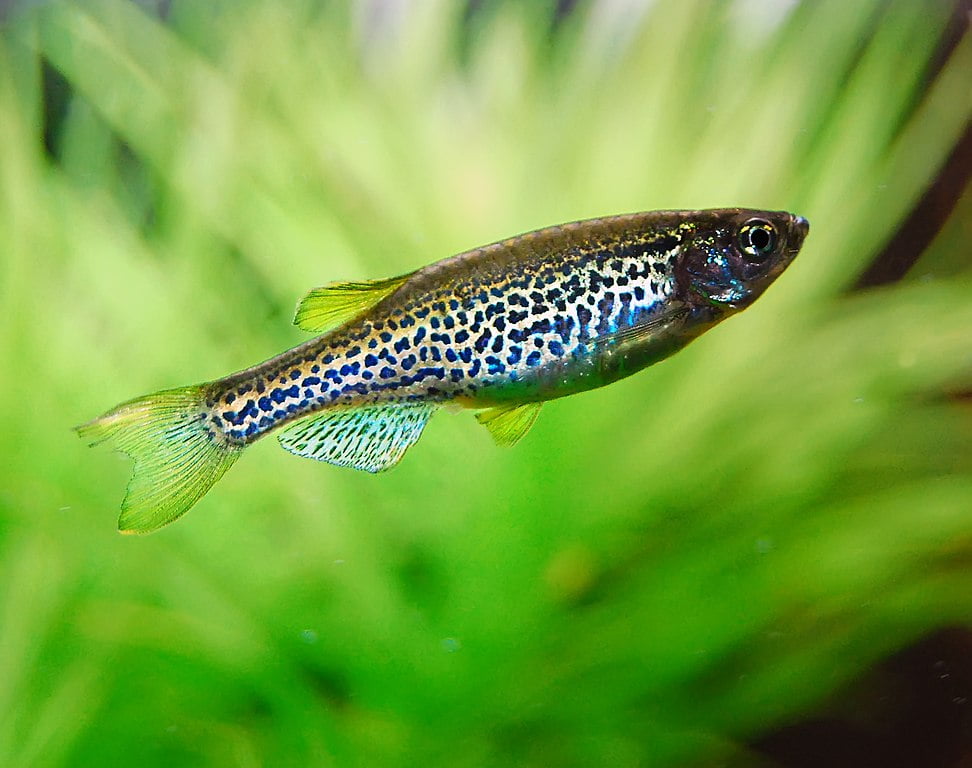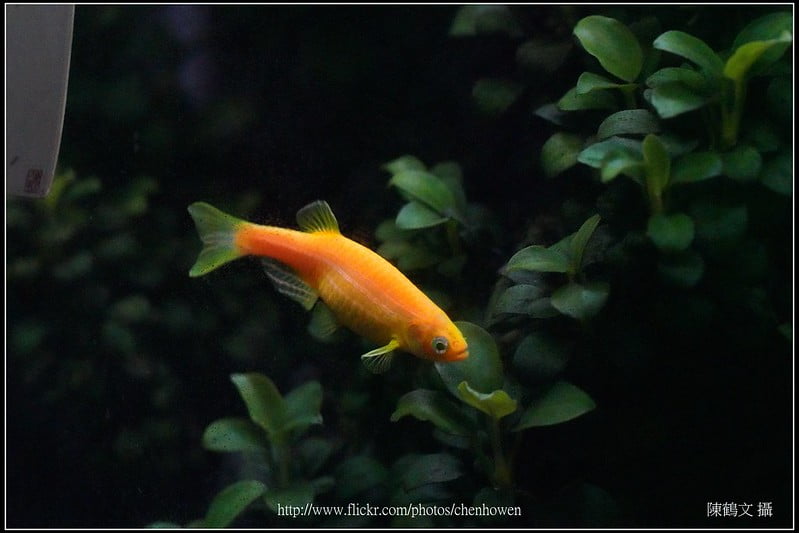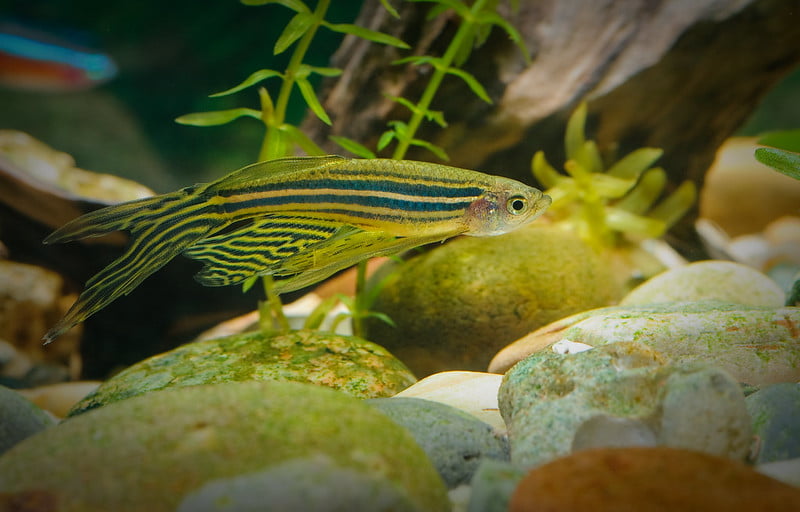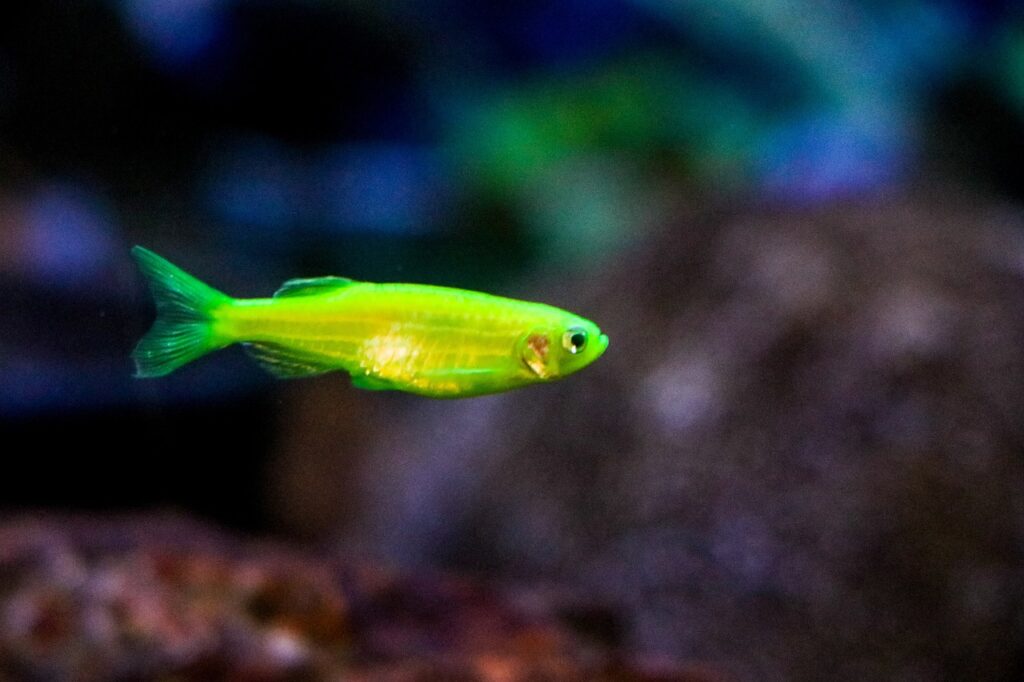Hey there! Today, we’re going to chat about a favorite in the aquarium world, the Zebra Danios, or as the scientists call them, Danio rerio. These little swimmers are part of the minnow family, Cyprinidae, and they’re related to other Danio species like the Giant Danio and the Pearl Danio. But what sets Zebra Danios apart are their distinctive blue stripes, reminiscent of a zebra’s pattern, hence the name.
Are Zebra Danios a rare find? Not at all! In fact, they’re quite popular in the aquarium trade, thanks to their hardiness and attractive appearance. They’re also pretty versatile, with several color variants including golden, albino, and long-finned. There’s even a spotted variant called the Leopard Danio. Talk about a diverse family!
When it comes to their natural habitat, Zebra Danios hail from South Asia. You can find them in a variety of water bodies, from rivers and streams to ponds and even rice fields. They’re not the type to stick to the bottom; they love swimming in the middle and top layers of the water. And when it comes to food, they’re not picky eaters. These omnivores enjoy a diet of small invertebrates and plant matter.
Let’s dive into some cool facts about our striped friends. Did you know that Zebra Danios are a big deal in scientific research? That’s right! Their regenerative abilities are quite impressive. They can regenerate their heart, spinal cord, retina, and other tissues. Plus, their rapid breeding cycle and ease of breeding in captivity make them a popular choice for research.
And if you thought that was interesting, wait till you hear this fun fact. Zebra Danios were among the first species to be sent into space for research purposes. How cool is that? And let’s not forget the GloFish, a genetically modified variant of the Zebra Danio, which was the first genetically modified animal to become publicly available as a pet.
The history of Zebra Danios in the aquarium world dates back to the early 1900s. They were first described by Francis Buchanan-Hamilton in 1822, and since then, they’ve become one of the most beloved aquarium fish. Their hardiness, attractive appearance, and playful behavior have made them a staple in home aquariums across the globe. So, if you’re thinking about adding some Zebra Danios to your tank, you’re in good company!
Table of Contents
Pricing, Common Names, and Variants of Zebra Danios
The price of Zebra Danios can vary depending on the variant, the size of the fish, and the location where you’re purchasing them. However, they are generally considered an affordable option for aquarium enthusiasts. In the United States, you could typically find Zebra Danios priced between $2 to $5 per fish. Keep in mind that prices may have changed since then, and it’s always a good idea to check with local pet stores or online retailers for the most current pricing.
Common Names
Zebra Danios are known by several common names, which can sometimes vary by region or variant. Some of the most widely used names include:
- Zebrafish: This is a common name that reflects the fish’s scientific name, Danio rerio.
- Striped Danio: This name refers to the characteristic blue stripes that run horizontally along the fish’s body.
- Zebra Fish: This is another common name that refers to the fish’s zebra-like stripes.
Variants
Zebra Danios come in several variants, each with its own unique appearance:
Leopard Danio

This variant has a spotted pattern instead of the characteristic stripes. Its scientific name is Danio rerio var. ‘frankei’.
Golden Zebra Danio

This variant has a golden hue but still maintains the characteristic zebra-like stripes.
Longfin Zebra Danio

This variant is similar to the standard Zebra Danio, but with longer, more flowing fins.
GloFish

This genetically modified variant of the Zebra Danio glows in the dark under ultraviolet light. They come in several different colors, including red, green, blue, purple, and orange.
Ideal Tank Size and Water Parameters for Zebra Danios
Recommended Tank Size
Zebra Danios are active swimmers and do their best in a tank that provides plenty of space for them to move around. A tank of at least 10 gallons is usually recommended for a small school of Zebra Danios, but a larger tank of 20-30 gallons would be even better. Remember, these fish are schooling fish and they prefer to be in groups of at least 5-6. The more space you can provide for them, the happier and healthier they’ll be.
Ideal Water Temperature
Zebra Danios are tropical freshwater fish and they thrive in a temperature range of 65-77 degrees Fahrenheit (18-25 degrees Celsius). It’s important to maintain a stable temperature within this range, as sudden changes can stress the fish and make them more susceptible to illness.
Preferred pH Level
Zebra Danios prefer a pH level between 6.5 and 8.0. They are quite hardy and can tolerate variations in pH, but sudden changes should be avoided. Regular testing of your aquarium water will help you ensure the pH stays within this range.
Suitable Water Hardness
Zebra Danios can tolerate a wide range of water hardness, but they do best in moderately hard water. The general hardness (GH) of the water should ideally be between 5 and 19 dGH (degrees of General Hardness). Regular testing can help you maintain the appropriate water hardness.
While Zebra Danios are hardy and adaptable, maintaining stable water conditions is key to their health and well-being. Regular monitoring and water changes will help keep your Zebra Danios happy and healthy.
Lifespan and Full Size of Zebra Danios
Average Lifespan in Captivity
Zebra Danios are known for their relatively long lifespan compared to other small aquarium fish. In a well-maintained aquarium, they typically live for 3-5 years, but some have been known to live even longer. Their lifespan can be influenced by a variety of factors, including diet, water quality, and overall care. Providing a balanced diet, maintaining good water quality, and regular health check-ups can contribute to a longer, healthier life for your Zebra Danios.
Typical Full Size in Length
Zebra Danios are small, streamlined fish that are built for active swimming. They typically grow to a length of about 2 inches (5 centimeters) when fully mature. Males and females are similar in size, although females may be slightly larger and have a more rounded body shape, especially when they are carrying eggs.
It’s important to note that while these are the typical sizes, individual Zebra Danios can vary somewhat in size. Factors such as genetics, diet, and overall health can influence the growth and size of these fish.
Natural Environment, Behavior, and Habitat Preference of Zebra Danios
Native Habitat
Zebra Danios are native to South Asia, specifically the regions of India, Pakistan, Bangladesh, Nepal, and Bhutan. They inhabit a variety of freshwater environments, including rivers, streams, ponds, and rice fields. These environments are typically slow-moving or stagnant and often have a dense growth of vegetation.
Typical Behavior Patterns
Zebra Danios are known for their active and playful behavior. They are schooling fish, meaning they prefer to be in groups and are often seen swimming together in a coordinated manner. This social behavior is a key aspect of their natural behavior and contributes to their overall health and well-being.
In an aquarium setting, Zebra Danios are generally peaceful but can be boisterous. They may nip at slow-moving fish with long fins, so it’s important to choose tank mates carefully.
Preferred Areas in the Water Column
Zebra Danios are not bottom-dwellers; they prefer to swim in the middle and top layers of the water. They are often seen darting around the upper levels of the tank, especially during feeding times. However, they will explore all levels of the tank, especially if there are plants or other forms of cover available.
Suggested Aquarium Decorations
When setting up an aquarium for Zebra Danios, aim to replicate their natural environment. This means providing plenty of swimming space, as well as areas of cover. Live plants are a great addition to a Zebra Danio tank, as they provide cover and also contribute to the water quality by absorbing nitrates.
Driftwood and rocks can also be used to create hiding spots and areas of interest. However, make sure any decorations are smooth and won’t injure the fish as they swim around.
Finally, a soft substrate, such as sand or fine gravel, can help replicate the riverbeds found in their natural habitat. While Zebra Danios are not bottom dwellers and won’t interact with the substrate as much as some other species, a soft substrate can still contribute to a natural-looking environment.
Suitable Tank Mates for Zebra Danios and Fish to Avoid
Compatible Tank Mates
Zebra Danios are generally peaceful and get along well with a variety of other fish species. They are schooling fish and prefer to be in groups of at least 5-6 of their own kind. In addition to their own species, they can be kept with other peaceful, active fish of a similar size. Some suitable tank mates for Zebra Danios include:
- Neon Tetras: Neon Tetras are small, peaceful fish with similar water condition preferences to Zebra Danios, making them a harmonious match. Their calm nature and preference for the middle and lower levels of the tank complement the Zebra Danios well.
- Guppies: Guppies are small, peaceful fish that can coexist with Zebra Danios. Their lively nature and small size make them a good match.
- Mollies: Mollies and Zebra Danios both prefer calm waters and have similar dietary needs, making them compatible tank mates.
- Swordtails: Swordtails are non-aggressive fish that are easy to maintain, making them a good choice for a shared tank with Zebra Danios.
- Harlequin Rasboras: Harlequin Rasboras are peaceful and easy-going fish. Their preference for the middle and upper levels of the tank complements the Zebra Danios’ swimming habits.
- Corydoras Catfish: Corydoras Catfish are peaceful bottom feeders that won’t compete with Zebra Danios for space. They also contribute to tank cleanliness.
- Ghost Shrimp: Ghost Shrimp are small, peaceful invertebrates that contribute to tank cleanliness. Their small size and quick movements allow them to coexist with Zebra Danios.
- Cherry Shrimp: Cherry Shrimp are small, non-aggressive invertebrates that contribute to tank cleanliness, making them a good choice for a Zebra Danios tank.
- Amano Shrimp: Amano Shrimp are slightly larger than Cherry Shrimp but maintain a peaceful demeanor and contribute to tank cleanliness.
- White Cloud Mountain Minnows: These minnows are peaceful fish that thrive in similar water conditions as Zebra Danios, making them a good choice for a shared tank.
- Endler’s Livebearers: Endlers are small, peaceful fish that can thrive in the same conditions as Zebra Danios, making them a good choice for a shared tank.
- Dwarf Gouramis: Dwarf Gouramis are peaceful fish that prefer the upper levels of the tank, making them a good match for Zebra Danios.
- Honey Gouramis: Honey Gouramis are peaceful fish that are easy to maintain, making them a good choice for a Zebra Danios tank.
- Bristlenose Plecos: Bristlenose Plecos are peaceful bottom dwellers. Their hard, armored bodies and preference for the sides and bottom of the tank allowed them to coexist with Zebra Danios.
- Otocinclus Catfish: Otocinclus are small, peaceful catfish that contribute to tank cleanliness. Their preference for the bottom and sides of the tank allows them to coexist with Zebra Danios.
- African Dwarf Frogs: These frogs are peaceful creatures that won’t disturb the Zebra Danios. Their unique behavior adds an interesting dynamic to the tank.
- Nerite Snails: Nerite Snails are peaceful invertebrates that contribute to tank cleanliness. Their hard shell provides protection from curious Zebra Danios.
- Cardinal Tetras: Cardinal Tetras are peaceful fish with similar size and water condition preferences to Zebra Danios, making them a good choice for a shared tank.
- Bamboo Shrimp: Bamboo Shrimp are peaceful invertebrates that filter feed. Their unique feeding habits and non-aggressive nature make them a good match for Zebra Danios.
- Rosy Barbs: Rosy Barbs are active fish that can hold their own against Zebra Danios. Their hardy nature and similar water condition preferences make them a good match.
Fish to Avoid
While Zebra Danios are generally peaceful, they are active and can be boisterous, which can stress slower, more sedate fish. They may also nip at the fins of slow-moving fish with long, flowing fins. Fish to avoid keeping with Zebra Danios include:
- Angelfish: These fish are slow-moving and have long fins that can be tempting for Zebra Danios to nip at.
- Betta Fish: Bettas are also slow-moving with long fins, and they prefer a more tranquil environment than Zebra Danios can provide.
- Large, Aggressive Species: Larger, more aggressive fish can see Zebra Danios as food. Avoid species such as Cichlids or large Catfish.
Each fish has its own personality, and individual variations can occur. Always monitor your aquarium closely when introducing new fish to ensure all inhabitants are getting along well.
Best Foods and Diet for Zebra Danios
Recommended Food Types
Zebra Danios are omnivorous, meaning they eat both plant-based and animal-based foods. In the wild, their diet consists of small invertebrates, algae, and other plant matter. In an aquarium setting, they can be fed a variety of foods to ensure they receive all the nutrients they need.
- Flake Food: High-quality flake food can form the basis of the Zebra Danio’s diet. It’s readily available and comes in formulations that provide a balanced diet for omnivorous fish.
- Live and Frozen Foods: Zebra Danios also enjoy live and frozen foods, such as brine shrimp, daphnia, and bloodworms. These foods can provide valuable protein and can be fed as a supplement to flake food.
- Vegetable Matter: While Zebra Danios will get some vegetable matter from their flake food, they can also be given small amounts of blanched vegetables, such as peas or spinach.
- Pellets: Small fish pellets can also be a good food source for Zebra Danios. Make sure the pellets are small enough for the fish to eat comfortably.
Feeding Frequency
Zebra Danios are active fish with a fast metabolism, so they prefer to eat small amounts of food several times a day rather than having one large meal. A good feeding schedule could be to feed them a small amount of food 2-3 times per day.
Only provide as much food as the fish can eat in a few minutes. Overfeeding can lead to poor water quality, as uneaten food will decompose in the tank. If you see uneaten food after feeding, it’s a sign that you’re feeding too much, and should reduce the amount of food given at each feeding.
A varied diet is key to keeping your Zebra Danios healthy. Providing different types of food will help ensure they get a range of nutrients and will also provide some dietary enrichment.
Breeding Tips for Zebra Danios
Ideal Breeding Conditions
Zebra Danios are relatively easy to breed in captivity. Here are some conditions that can encourage breeding:
- Separate Breeding Tank: It’s best to set up a separate breeding tank to protect the eggs and fry from being eaten by adult fish. A 10-gallon tank is usually sufficient.
- Water Conditions: The water in the breeding tank should be slightly acidic (pH around 6.5-7.0) and at a temperature slightly higher than the main tank, around 78-80 degrees Fahrenheit (25-27 degrees Celsius).
- Tank Setup: The breeding tank should have a layer of marbles or a spawning grid at the bottom. This allows the eggs to fall into a place where the adults can’t reach them. You can also add fine-leaved plants or a spawning mop as a place for the fish to spawn.
Breeding Behavior
When ready to breed, males will chase the females around the tank. Spawning usually occurs in the early morning and results in the female releasing eggs, which the male then fertilizes. Zebra Danios are not livebearers, so the eggs will be scattered around the tank, often sticking to surfaces like plants or the sides of the tank.
Care for Eggs and Fry
Once spawning has occurred, it’s best to remove the adult fish from the breeding tank to prevent them from eating the eggs. The eggs will hatch in about 2-3 days.
The fry will initially feed on their yolk sacs. Once they are free-swimming, usually after about 3 days, they can be fed infusoria or commercially available fry food. As they grow, they can be fed finely crushed flake food or baby brine shrimp.
It’s important to maintain good water quality in the breeding tank, as fry can be sensitive to poor conditions. Regular water changes and careful monitoring of water parameters can help ensure the fry grows up healthy.
FAQs
Are Zebra Danios aggressive?
Zebra Danios are generally peaceful but can be boisterous. They may nip at slow-moving fish with long fins, so it’s important to choose tank mates carefully.
Can Zebra Danios live alone?
Zebra Danios are schooling fish and prefer to be in groups of at least 5-6. They are more likely to exhibit stress behaviors when kept alone.
How can I tell the difference between male and female Zebra Danios?
Males and females are similar in size, although females may be slightly larger and have a more rounded body shape, especially when they are carrying eggs.
Are Zebra Danios good for beginners?
Yes, Zebra Danios are a great choice for beginners. They are hardy, adaptable, and easy to care for, making them a good choice for those new to fish-keeping.
Do Zebra Danios need a heater in their tank?
While Zebra Danios can tolerate a wide range of temperatures, they are tropical fish and do best in water temperatures between 65-77 degrees Fahrenheit. If your room temperature consistently falls below this range, a heater would be necessary to maintain the appropriate temperature.
How can I tell if my Zebra Danios are healthy?
Healthy Zebra Danios are active and have clear eyes, vibrant coloration, and full, rounded bodies. They should be eager to eat and exhibit normal swimming behaviors. Signs of illness may include lethargy, loss of appetite, faded coloration, spots or fungus on the body, or abnormal swimming patterns.
Can Zebra Danios jump out of the tank?
Like many fish species, Zebra Danios are capable of jumping, so it’s a good idea to have a secure lid on your aquarium to prevent them from jumping out.
How quickly do Zebra Danios grow?
Zebra Danios grow relatively quickly, reaching their full size of about 2 inches in length within a few months, given proper nutrition and care.
Can Zebra Danios live with bettas?
While it’s possible for Zebra Danios and bettas to coexist, it’s generally not recommended. Zebra Danios are active swimmers and may stress a betta, and they may also nip at a betta’s long fins.
Are Zebra Danios nocturnal?
Zebra Danios are not nocturnal. They are most active during the day and will sleep at night when the lights are off.
Do Zebra Danios need a filter in their tank?
Yes, Zebra Danios require a filter in their tank. The filter helps to remove waste, excess food, and potentially harmful chemicals from the water, keeping it clean and healthy for the fish.
Can Zebra Danios change color?
Zebra Danios can change their color slightly based on their mood, health, and environmental conditions. However, drastic or sudden color changes can be a sign of stress or illness.
How can I encourage my Zebra Danios to breed?
To encourage breeding, you can slightly increase the water temperature, provide plenty of hiding spots for the eggs, and ensure the fish are well-fed. It’s also recommended to separate the adults from the eggs once spawning has occurred to prevent them from eating the eggs.
How many eggs do Zebra Danios lay?
A female Zebra Danio can lay several hundred eggs at a time. However, not all of these eggs will be fertilized or survive to hatch.
Can Zebra Danios live in a bowl?
While Zebra Danios can technically survive in a bowl, it’s not an ideal environment for them. They are active swimmers and need plenty of space. A small bowl does not provide adequate space or the necessary filtration to keep the water clean and healthy.
Can Zebra Danios live with goldfish?
While Zebra Danios and goldfish can tolerate similar water temperatures, they have different needs and behaviors that can make them incompatible. Goldfish produce a lot of waste which can lead to poor water conditions for Zebra Danios. Also, larger goldfish may see smaller fish like Zebra Danios as food.